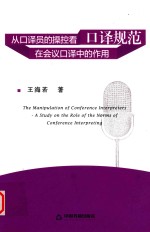

从口译员的操控看口译规范在会议口译中的作用PDF电子书下载
- 电子书积分:9 积分如何计算积分?
- 作 者:王海岩著
- 出 版 社:北京:中国书籍出版社
- 出版年份:2016
- ISBN:7506855426
- 页数:192 页
Chapter One Introduction 2
1.Necessity for the Study 2
1.1 Rationale 3
1.1.1 Importance of Understanding the Social Aspects of Conference Interpreting 3
1.1.2 Calling for Social-oriented Approach of Interpreting Studies 5
1.2 Significance of the Study 11
1.2.1 Theoretical Contribution 11
1.2.1.1 Enhancing the Understanding of the Norm-observing Behavior of Conference Interpreters 11
1.2.1.2 Complementing the Sense-making Mechanism in the New Paradigm of Interpreting Studies 12
1.2.2 Practical Contribution 15
2.Overview of the Dissertation 15
Chapter Two Literature Review 17
1.Introduction 17
2.Approaches of Translation Studies and Interpreting Studies 17
2.1 Different Approaches in Translation Studies 17
2.1.1 Text-oriented Approach in Translation Studies 17
2.1.2 Human-oriented Approach in Translation Studies 18
2.2 The Social-oriented Approach of Interpreting Studies 22
2.2.1 Conundrum of Previous Models of Interpreting Studies 22
2.2.2 Social-oriented Approach of Interpreting Studies 25
2.2.3 Corpus Translation Studies and Corpus Interpreting Studies 26
2.2.3.1 Corpus Translation Studies 27
2.2.3.2 Corpus Interpreting Studies 28
2.3 Research on Norms of Interpreting 30
2.4 Research on Norms of Interpreting Based on Real-life Corpus 35
3.Norms Theory 38
3.1 Norms in Sociological Studies 38
3.2 Norms in Translation Studies in General 40
3.2.1 Toury's Norms 43
3.2.2 Chesterman's Norms 45
3.3 The Rationale for Introducing Theories of Translation Studies into Interpreting Studies 51
3.3.1 The Translation and Interpreting Practices as Communication 51
3.3.2 Common Grounds of Research 53
3.3.3 Differences in Research 56
3.3.4 Disciplinary Attribution 57
4.Strategies 59
4.1 The Concept of Strategies 60
4.2 Classification of Strategie 60
5.Summary 62
Chapter Three Research Design and Methodology 64
1.Introduction 64
2.Research Question Analysis 64
2.1 Research Question 64
2.2 The Conversion of the Conceptual hypothesis into Operationalizable Hypothesis(H′) 65
3.Unit of Analysis and Variables 66
3.1 Control of Variables 66
3.1.1 The Rationale for the Choice of Professional Interpreters 67
3.1.2 The Rationale for the Choice of Real-life Interpreting Events 70
3.2 Corpus Establishment 70
3.2.1 Transcription 71
3.3 Data Selection 72
3.4 Values of the Independent Variable-Norms 74
3.5 Values of the Dependent Variable-Strategies 78
4.Analysis of the Research Question and Conceptual hypothesis 79
5.Summary 85
Chapter Four Data Analysis and Discussion of Results 86
1.Introduction 86
2.Criteria for the Variables 86
2.1 Criteria for the Independent Variable 86
2.2 Criteria for the Dependent Variable 89
2.2.1 Syntactic/Grammatical Strategies 89
2.2.2 Semantic Strategies 100
2.2.3 Pragmatic Strategies 106
2.3 Conformity Test for the Assignment of the Categories of the Independent and Dependent Variables 116
3.Quantitative Analysis 120
3.1 Statistical Analysis 121
3.1.1 Method of Testing the Research Question and Conceptual ypothesis 121
3.1.2 Application of Statistics 121
3.2 Discussion 124
3.2.1 Discussion on the Results of Statistics 124
3.2.1.1 Frequency Distribution 124
3.2.2 The Acceptance of the Four Hypotheses 130
4.Qualitative Analysis 131
4.1 Qualitative Analysis on the Results of the Statistics 131
4.1.1 Analysis of Point 3 and Point 4 of the Findings 131
4.1.2 Analysis of Point 1 and Point 2 of the Findings 147
Chapter Five Findings and Conclusions 149
1.Introduction 149
2.Major Findings 149
2.1 heoretical Explanations for the Norm-governed Behaviors of Conference Interpreters 151
2.2 Quantitative Analysis Results 152
2.3 Qualitative Analysis Results 154
3.Implications 155
3.1 Theoretical Implications 155
3.1.1 A Step Forward in the Norms Theory and Its Possible Derivatives 156
3.1.2 Complementing the Sense-making Mechanism of the IT and CP Paradigms 158
3.2 Practical Implications 160
3.2.1 Implications for the Training of Conference Interpreters 160
3.2.2 Implications for the Practice of Conference Interpreters 161
4.Limitations of the Study 162
5.Directions for Further Research 164
6.Concluding Remarks 165
Bibliography 167
Appendix Ⅰ 184
Appendix Ⅱ 190
- 《会议服务》黄程主编 2015
- 《商务英语口译教程 第3版》朱佩芬,徐东风编著 2017
- 《口译理论研究》王斌华著 2019
- 《高超声速流动中的激波及相互作用》杨基明,李祝飞,朱雨建,张恩来,王军编者 2019
- 《会议学与会议管理 第3版》向国敏著 2019
- 《七个会议》(日)池井户润 2019
- 《中国城镇化发展与碳排放的作用关系及碳减排策略研究》施建刚,李佳佳著 2019
- 《法语口译综合能力专项训练》陈伟主编 2019
- 《多尺度空间视角下城市群城镇化发展对碳排放的作用机理研究》王锋著 2019
- 《植酸和植酸酶的生理与免疫调节作用》刘宁著 2017
- 《中国当代乡土小说文库 本乡本土》(中国)刘玉堂 2019
- 《异质性条件下技术创新最优市场结构研究 以中国高技术产业为例》千慧雄 2019
- 《中国铁路人 第三届现实主义网络文学征文大赛一等奖》恒传录著 2019
- 《莼江曲谱 2 中国昆曲博物馆藏稀见昆剧手抄曲谱汇编之一》郭腊梅主编;孙伊婷副主编;孙文明,孙伊婷编委;中国昆曲博物馆编 2018
- 《中国制造业绿色供应链发展研究报告》中国电子信息产业发展研究院 2019
- 《中国陈设艺术史》赵囡囡著 2019
- 《指向核心素养 北京十一学校名师教学设计 英语 七年级 上 配人教版》周志英总主编 2019
- 《《走近科学》精选丛书 中国UFO悬案调查》郭之文 2019
- 《清至民国中国西北戏剧经典唱段汇辑 第8卷》孔令纪 2018
- 《北京生态环境保护》《北京环境保护丛书》编委会编著 2018
